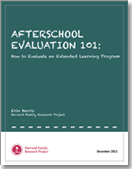The Harvard Family Research Project separated from the Harvard Graduate School of Education to become the Global Family Research Project as of January 1, 2017. It is no longer affiliated with Harvard University.

|
December 12, 2011 Afterschool Evaluation 101: How to Evaluate an Expanded Learning ProgramErin Harris |
Article Information
- Full Text (HTML)
- Full Text (PDF: 453 kb)
Have you applied to pilot Afterschool Evaluation 101?
To enhance future versions of the guide, we are seeking out-of-school time/expanded learning program directors to pilot Afterschool Evaluation 101.
Read our FAQ about the pilot process.
Afterschool Evaluation 101 is a how-to guide for conducting an evaluation. It is designed to help out-of-school time (OST) program directors who have little or no evaluation experience develop an evaluation strategy. The guide will walk you through the early planning stages, help you select the evaluation design and data collection methods that are best suited to your program, and help you analyze the data and present the results.
Evaluation helps your OST program measure how successfully it has been implemented and how well it is achieving its goals. You can do this by comparing the activities you intended to implement and the outcomes you intended to accomplish to the activities you actually implemented and the outcomes you actually achieved.
HOW TO USE THIS TOOLKIT
This toolkit stresses the need to create a larger evaluation strategy to guide your evaluation plans. An evaluation strategy involves developing a well-thought out plan for evaluating your program, with the goal of incorporating the lessons learned from the evaluation into program activities. As part of this larger strategy, evaluation is not viewed merely as a one-time event to demonstrate results, but instead as an important part of an ongoing process of learning and continuous improvement. This toolkit will walk you through creating an evaluation strategy, planning an evaluation, and working with evaluation data.
Afterschool Evaluation 101 is structured in a series of nine steps:
- Step 1 helps you to determine the overall purpose of your evaluation.
- Step 2 outlines how to create a logic model, which is a visual representation of your program strategy that can guide your evaluation.
- Step 3 describes how to think through what resources you have available (staffing, etc.) to actually conduct an evaluation.
- Step 4 discusses how best to focus your evaluation, based on your program’s needs, resources, and developmental stage.
- Steps 5 and 6 cover selecting the evaluation design and data collection methods that are best suited to your program.
- Steps 7, 8, and 9 contain information about what to do with the data once you have it, including how to conduct and write up the analysis and, perhaps most importantly, how to use the data that you have analyzed.
Tell us what you think
Recognizing the benefits of learning and continuous improvement, we view Afterschool Evaluation 101 as a work in progress and have called it “Version 1.0” as a result. We welcome feedback about your experience using the toolkit and any other improvements you would like to see in a future version. Please direct your feedback to Erin Harris at erin_harris@gse.harvard.edu.
Free. Available online only.
